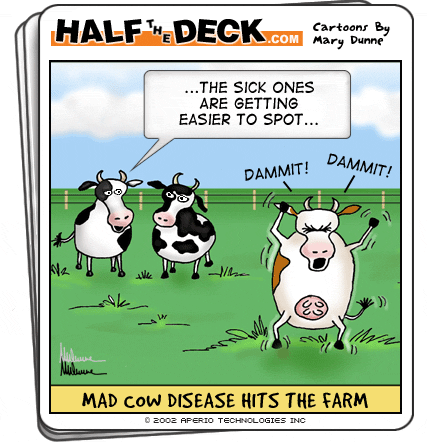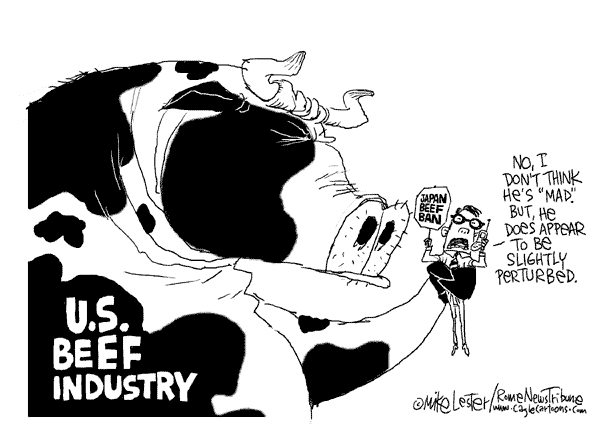January 14, 2005
Mad Cow
Have you ever tried to imagine how a mad cow acts?
Leading Canadian official wants cows massacredPosted by Susan R at January 14, 2005 04:28 PMThe Globe & Mail
Friday 14th January, 2005Ralph Klein, Premier of the Canadian state of Alberta, has called for a mass slaughter of older cattle.Klein wants to convince consumers and Canada's trading partners that the domestic beef supply is free from mad-cow disease.
That kind of Draconian step would be aimed at the 1.76 million animals born before August, 1997, when Canada began to halt the widespread practice of feeding cattle protein made from the body parts of other cattle.
A mass slaughter has, until now, been an unthinkable prospect for Canada's cattle industry, since it would wipe out animals worth more than $1-billion before the start of the mad-cow crisis and which would still fetch upward of $350-million today.
But Mr. Klein said yesterday that talk has already started about a large-scale cull of cattle, after this week's discovery of the fourth case of bovine spongiform encephalopathy in a Canadian cow.
'Personally, and from what I hear, is a cull necessary? The answer is yes. I think that the ranching industry will come to that conclusion and devise a way to achieve that cull,' Mr. Klein told reporters in Toronto, where he gave a speech to the Empire Club of Canada.
Several ranchers and a major industry group confirmed yesterday that a mass cull is indeed being discussed as a way to ensure that the U.S. import ban on shipments of Canadian cattle ends as scheduled in early March. But the Canadian industry's fight is about to get tougher, with the U.S. Senate confirming yesterday that it will hold public hearings next month to review the plan to reopen the border to Canadian cattle under 30 months of age. Cattle most likely to be slaughtered would not have been allowed into the United States under those changes.
Since May, 2003, three cattle that were born before 1997 in Canada have tested positive for BSE; just this week, an Alberta cow born in 1998 was found to have the disease.
That suggested Canada's supposedly tough new feed rules weren't followed and threw into question whether the United States would still open its border March 7 to young Canadian cattle and beef according to its current plan.
Officially, the Bush administration says it is 'on track' to reopen the border. But U.S. Agriculture Secretary Ann Veneman has also made it clear that the United States will closely monitor the Canadian-led investigation into the possible source of the latest infection.
'We are going to send a team to Canada to help with the investigation,' Ms. Veneman told reporters. 'We will continue to investigate this process to determine if there are any different actions that need to be taken.
'Although the Senate does not have the formal authority to keep the border closed, it can provide a high-profile platform that could make it politically awkward for the White House to go ahead.
Already, the head of the Senate agriculture committee has signaled that he believes the latest case of BSE, in an animal born after the feed ban was put in place, is a problem. 'A second case in a month of BSE from a Canadian-born cow raises some serious questions regarding Canada's compliance with its feed ban,' Republican Saxby Chambliss said. The agriculture committee in the House of Representatives is expected to begin a similar probe.
Ottawa is worried that the discovery of another infected cow will bolster the arguments of protectionist U.S. forces and put pressure on the U.S. government to reconsider the resumption of cattle shipments.
'[People] are still concerned about the possibility of the lobby on the Hill putting pressure on the U.S. government to back step,' said one senior federal official.But the optics of a mass cull could be a problem. Television images of mass burials and piles of burning carcasses in Britain were a potent and constant reminder of the BSE scare there in the 1990s. 'What I'm hoping to avoid is the idea of pits of dead cattle scattered across the countryside,' said Cindy McCreath, a spokeswoman with the Canadian Cattlemen's Association.
Some ranchers see a wholesale slaughter as a way to undermine the protectionist lobby in the United States. That support is firm, even though a mass slaughter would, at a minimum, mean sharply lower selling prices for each animal and could mean that carcasses would be disposed of without any payment. 'If it's that or the industry, let's take the haircut,' said Brent Stutheit, who has a 250-head herd in the foothills west of Red Deer, Alta.
One industry veteran said it is unlikely that the carcasses from a mass slaughter would be sold, since such an influx would overwhelm stockyards, slaughterhouses and freezers. 'We don't even have close to the facilities to do that,' said Will Irvine, general manager at the Calgary Stockyards.
Despite Mr. Klein's personal support for the idea of a mass slaughter, he is not yet proposing any payouts for the beef industry. A spokeswoman for Mr. Klein said it is 'far too early' to consider a compensation package.
Support for a cull is far from universal. 'Certainly Premier Klein has his ideas,' said Elizabeth Whiting, spokeswoman for federal Agriculture Minister Andy Mitchell. 'It's not something we are thinking about right now.'
Federal Conservative agriculture critic Diane Finley said culling 1.76 million old cattle would be a 'dramatic overreaction,' and her party is crunching the numbers to propose a more limited cull program. Among the provinces, Ontario said calls for a cull are premature, while British Columbia said a mass slaughter is not necessary at the moment.
Investigators from the Canadian Food Inspection Agency are now at the Alberta farm where the infected animal was found and have quarantined the herd. Twenty-two animals from the infected cow's birth cohort have been identified, and were killed yesterday morning so they could be tested for BSE. Test results are expected late tomorrow or on Saturday.
The agency said there was one spot of good news for Canada's cattle industry: Tests on nine animals from the birth cohort of the cow confirmed as infected in late December have all come back negative, confirming that those animals were healthy. The CFIA added that four additional animals were exported to the United States, rather than the single animal previously disclosed.

